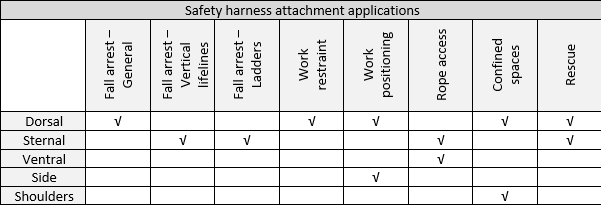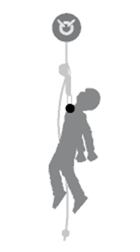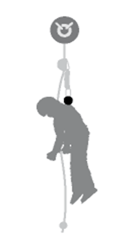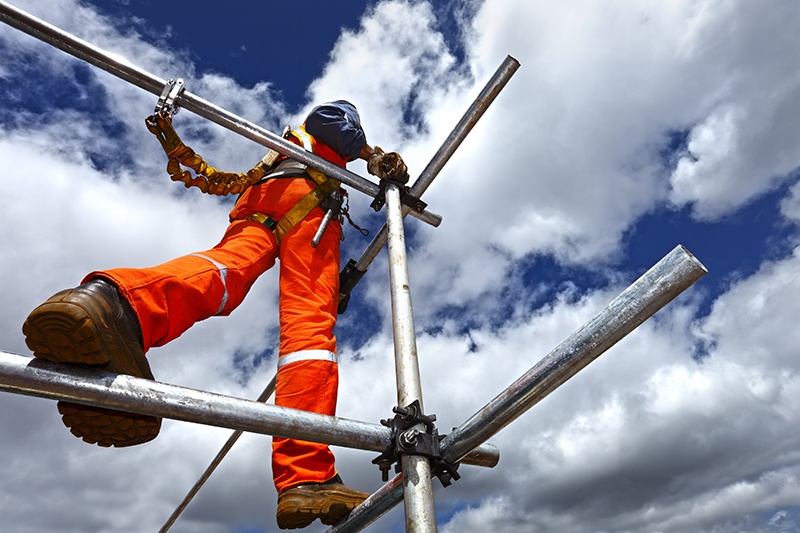
There is a common belief amongst employers that all height safety harnesses are the same, and that more affordable harnesses will provide their workforce with the same protection as expensive harnesses. Unfortunately, this is not true. Harnesses are designed for specific tasks at height, ranging from basic fall arrest harnesses to top-of-the-range rope access harnesses.
Employers must therefore carefully consider the tasks they need their workforce to perform before procuring safety harnesses.
Below are two examples of harnesses available:
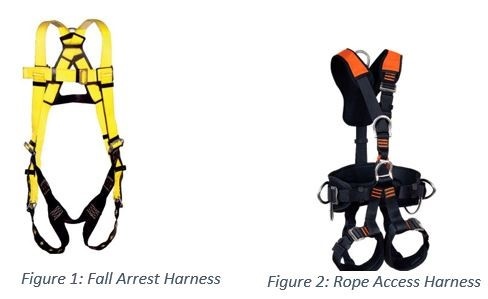
The harness in Figure 1 is a typical fall arrest harness, with a dorsal (back) attachment point between the shoulder blades, while the harness in Figure 2 is a typical rope access harness with dorsal (back), sternal (front), ventral (lower front), as well as side attachment points for work positioning.
Apart from the attachment points on the two harnesses above, the differences in the two leg straps must be noted as well. Fall arrest harnesses are designed to ‘catch’ falling workers, while rope access harnesses are designed for rope access technicians who must ascend, descend or traverse ropes in difficult-to-reach areas. After a fall, the leg straps of a fall arrest harness will place pressure on the worker’s blood vessels, restricting blood flow to and from his heart and brain. The longer the worker is suspended in this type of harness, the bigger the risk of him sustaining suspension trauma.
It must be noted that some fall arrest harnesses also have sternal (front), as well as side attachment points for work positioning. They are also generally more affordable than rope access harnesses.
The purpose of various attachment points on fall arrest and rope access harnesses
In the absence of sufficient SANS/EN guidelines, ANSI and CSA standards were consulted for this blog post. The Canadian Standards Association (CSA) regulates the classifications for full body harnesses in Canada. According to the CSA, a harness can have more than one classification, however, all full body harnesses must meet the requirements for class A Fall Arrest Harnesses.
Classes of harnesses
The following unpacks each class of harness and how they conform to the relevant standards.
Class A: Fall arrest
Class A harnesses are designed to protect workers when they are six feet (1.8 m) or more above the ground. They support the body during and after a fall. Dorsal (back) attachment points are used for fall protection. They slide on impact, keeping the worker in an upright position.
Class AD: Suspension and controlled descend
Class AD harnesses are used to support and hold a worker while they are raised and lowered. There is one sternal (front) attachment point and one dorsal (back) attachment point. The sternal attachment point is used for attachment to a descending device.
Class AE: Limited access
Class AE harnesses are designed to raise or lower a worker through a confined space area. Shoulder attachment points serve as anchorage points for attaching an extraction or other rescue device. The attachment points slide on the shoulder strap for optimal positioning of the worker.
Class AL: Ladder climbing
Class AL harnesses are designed for use with a fall arrester that travels on a vertical lifeline or on a rail. This fall arrester is often referred to as a rope grab. Sternal (front) attachment points are used for attachment to the vertical lifeline system.
Class AP: Work positioning
Class AP harnesses will hold or suspend a worker at a specific location, allowing full use of the worker’s hands. Side or hip attachment points are used for positioning.
It must be noted that both ANSI Z 359 as well as CSA Z 259 consider sternal (front) attachment points on fall arrest harnesses as ladder climbing connections for guided type fall arrestors where there is no chance of a fall in a direction other than feet first.
The latest version of the ANSI Z 359 standard for personal fall arrest systems allows the sternal (front) attachment point on a safety harness to be used in conjunction with a fall arrest system only if it limits:
- the maximum free fall distance to 0.6 m, and
- the maximum arresting force to 4 kN.
Using the sternal (front) attachment point on a Class A fall arrest harness in conjunction with a shock absorbing fall arrest lanyard, where the maximum free fall distance could exceed 0.6 m, is therefore not advisable.
Standard practice is to use the dorsal (back) attachment point for the fall arrest lanyard and to keep the sternal (front) attachment point open for:
- a vertical lifeline,
- ladder climbing, and
- for controlled descend (rescue).
|
Figure 3: Sternal attachment |
|
Figure 4: Dorsal attachment |
|
The safety harness attachment applications
